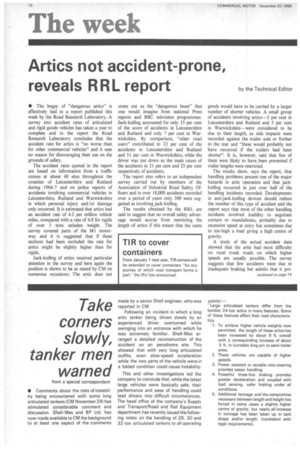Take corners • slowly, tanker men warned
Page 14

Page 15

If you've noticed an error in this article please click here to report it so we can fix it.
from a special correspondent
• Comments about the risks of instability being encountered with some long articulated tankers iCM November 29) has stimulated considerable comment and discussion. Shell-Mex and BP Ltd. has now made available to CM the background to at least one aspect of the comments made by a senior Shell engineer. who was reported in CM.
Following an incident in which a long artic tanker being driven slowly by an experienced driver overturned while swinging into an entrance with which he was extremely familiar. Shell-Mex arranged a detailed reconstruction of the accident on an aerodrome site. This showed that with very long articulated outfits, even slow-speed acceleration while the two parts of the vehicle were in a folded condition could cause instability.
This and other investigations led the company to conclude that, while the latest large vehicles were basically safe, their performance and ease of handling could lead drivers into difficult circumstances. The head office of the company's Supply and Transport/Road and Rail Equipment department has recently issued the following notes on the handling of 28. 30 and 32-ton articulated tankers to all operating
points:—
Large articulated tankers differ from the familiar 24-top artics in many features. Some of these features affect their road characteristics.
To achieve higher vehicle weights now permitted, the length of these artics has been increased by about 8 ft. overall with a corresponding increase of about 5 ft. in turntable king-gin to semi-trailer axles.
2. These vehicles are capable of higher speeds.
3. Power assisted or variable ratio steering provides easier handling.
4. Powerful three-line braking provides greater deceleration and coupled with load sensing, safer braking under all conditions.
5. Additional tonnage and the compromise necessary between length and height has forced in some cases a slightly higher centre of gravity, but nearly all increase in tonnage has been taken up in tank shape and/or length, {consistent with legal requirements).
Higher speeds, easier handling and improved stopping are all very desirable features, but can instil over-confidence in drivers, and when this happens these improved features will affect stability on certain types of cornering. There is now more enticement to approach corners and roundabouts at higher speeds, bearing in mind the greater stopping power and ease of steering.
If a corner or roundabout is preceded by fairly harsh braking, a transfer of load takes place in spite of multibaffled tanks. Coupling this with change in direction and early acceleration (whilst still in the bend) before the semi-trailer has straightened out, an unstable condition can arise which could result in a vehicle turning over.
In these newer type artics (because of the length of the tank) the angle of articulation is greater for a given corner than for previous antics, where acceleration could be applied as the vehicle lined itself up much sooner. At any angle of articulation the momentum of the load acts in a different direction to the line of travel of the tractor and it is this condition which is one cause of instability, Therefore under any condition of fold up the vehicle must be allowed to straighten up before accelerating away.
The action of negotiating a roundabout is a little different from an acute corner. First, the speed of the vehicle would normally be higher on the approach. Second, on entering a roundabout and steering left a certain amount of load transfer takes place opposite to the direction of turn. When the opposite lock is employed, the load transfer reverses direction immediately and the semi-trailer tends to roll. This roll characteristic is not appreciably transmitted through the turntable king-pin to the driver (as is felt on a rigid) and therefore an over-confident approach and subsequent roundabout negotiation, coupled with early acceleration, can cause excessive roll to be generated. This second change of direction is by far the most critical of the manoeuvre.
The situations described above are aggravated (a) when the tank is only partially laden, as the degree of load transfer is greater, and (b) when negotiating an adverse cambered roundabout or right hand turn.
With the Company's road tanker fleet, the height centre of gravity remains consistent compared with many other road haulage articulated vehicles in which the centre of gravity can vary widely with each different loading and is therefore a relatively unknown factor. Because of this our vehicles are much safer to handle.
Recent tests have shown that a given corner can be negotiated safely at about 12 m.p.h. However, when the same corner was approached at a higher speed and the vehicle braked harshly down to 8 m.p.h. at the start of the corner combined with early acceleration out of the corner, the vehicle became unstable and all but turned over.
In conclusion, vehicles now being built for the Group contain all the features needed for ease of operation and are safe, provided these elementary principles are followed.
Drivers should recognize the fact that corners and roundabouts must be negotiated at speeds slower than they think possible.
Shell's prompt action in investigating the accident in detail, and then issuing handling notes, is very commendable.


























































































